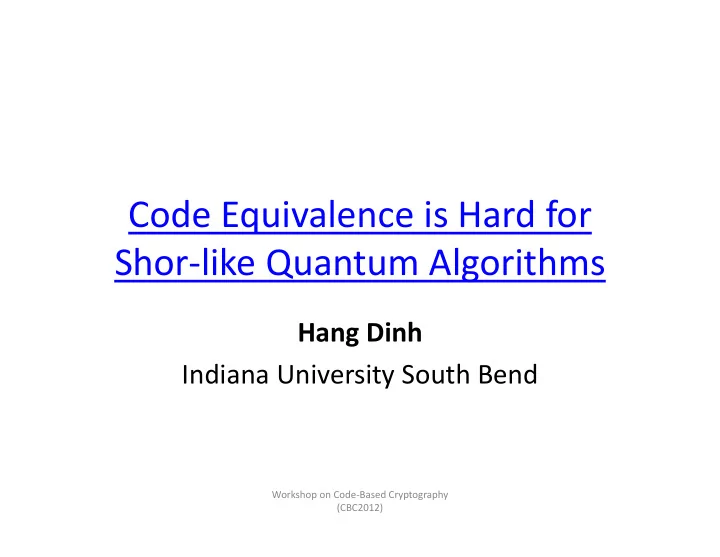

Code Equivalence is Hard for Shor ‐ like Quantum Algorithms Hang Dinh Indiana University South Bend Workshop on Code ‐ Based Cryptography (CBC2012)
Code Equivalence (CE) • The CE Problem: – Given two linear codes C and C’ – Decide if C is equivalent to C’ up to a permutation of the codeword coordinates • Petrank and Roth, 1997 proved – Code Equivalence is unlikely NP ‐ complete, – but is at least as hard as Graph Isomorphism • There’s an efficient reduction from Graph Isomorphism to CE Hang Dinh ‐ Indiana University South Bend 2
Code Equivalence (CE) • A search version of CE: – Given two permutation ‐ equivalent linear codes C and C’ – Find a permutation between C and C’ • Related to security of McEliece ‐ type cryptosystems – In the case where the secret code is known • Support Splitting Algorithm [Sendrier 1999] – Efficient for codes with small hull dimension, including Goppa codes and many binary codes – Inefficient for other codes, such as Reed ‐ Muller codes. Hang Dinh ‐ Indiana University South Bend 3
Hidden Subgroup Problem (HSP) • HSP is a generalization of problems possibly solved by Shor ‐ like quantum algorithms. • HSP over a finite group G : – Input: a black ‐ box function f on G that distinguishes the left cosets of an unknown subgroup H <G, i.e., � � � � � �� � �� – Output: a generating set for H . • There is a natural reduction from CE to HSP – where the group G is non ‐ abelian (a rich wreath product) – So, can CE be solved efficiently by Shor ‐ like algorithms? Hang Dinh ‐ Indiana University South Bend 4
Quantum Fourier Sampling (QFS) ‐ Quantum part of Shor ‐ like algorithms Uniform superposition over G uniform superposition over the coset gH Apply quantum black box for f random coset state gH Quantum Fourier transform distribution over G weak on ρ ij , i , j Measure gH distribution strong , i , j on ( ρ , i, j ) block matrix corresponding to irreducible representation ρ Hang Dinh ‐ Indiana University South Bend 5
Efficiency of Shor ‐ like Algorithms • Shor’s quantum algorithms efficiently solve factorization – HSP over cyclic groups Z N discrete logarithm – HSP over Z N ×Z N • Quantum Fourier Sampling – Efficient for HSP over abelian groups – There are efficient quantum Fourier transforms for certain non ‐ abelian cases [See Lomont 2004 for a survey]. – But inefficient (or not known to be efficient) for interesting non ‐ abelian cases, including symmetric and dihedral groups. Hang Dinh ‐ Indiana University South Bend 6
Our Results • We show that in many cases of interest, – Solving the case of HSP reduced from CE by QFS requires rich, entangled measurements. • Our results apply to many codes, including – Classical Goppa codes, rational Goppa codes [Dinh, Moore, Russell, CRYPTO 2011] – Reed ‐ Muller codes (used in the Sidelnikov cryptosystem) [Dinh, Moore, Russell, Preprint 2011 , arXiv:1111.4382] Shor ‐ like algorithms are unlikely to help break code ‐ based cryptosystems in these cases. Hang Dinh ‐ Indiana University South Bend 7
HSP ‐ hard Codes • What codes make CE hard for Shor ‐ like algorithms? – A linear code � is called HSP ‐ hard if strong QFS reveals negligible information about the permutation between � and any code equivalent to � . • Theorem [Dinh, Moore, Russell, CRYPTO 2011] : Let be a ‐ ary 2 ‐ code s.t. . Then is HSP ‐ hard if � The automorphism group ������ has size � � ���� 1) The minimal degree of ������ is � Ω��� . 2) the minimal number of coordinates moved the minimal number of coordinates moved by a non ‐ identity permutation in ������ ������ Hang Dinh ‐ Indiana University South Bend 8
Reed ‐ Muller Codes are HSP ‐ hard • Binary Reed ‐ Muller code � � – has length � � 2 � and dimension � � ∑ . � ��� – If � � 0.1� , then � 2 � 0.2�� for sufficiently large � . � , then • If is a binary Reed ‐ Muller code of length |������| � 2 � � �� � 2 ����� � �� � � ���� 1. 2. The minimal degree of ������ is exactly 2 ��� � �/2 . Proof: Use the fact that � ������ = general affine group of space � � Hang Dinh ‐ Indiana University South Bend 9
Open Question • Are there other HSP ‐ hard codes that are of cryptographic interest? Hang Dinh ‐ Indiana University South Bend 10
Recommend
More recommend